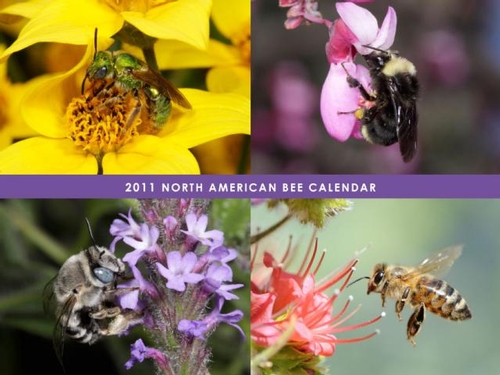Mark your calendar.
If you're a bee aficionada and haven't ordered your educational North American Bee Calendar, you have until Tuesday, Nov. 30 to place your order.
It's for a good cause. Proceeds benefit the pollination services work by the Xerces Society for Invertebrate Conservation and the Great Sunflower Project.
This is an order-online-only calendar, says Celeste Ets-Hokin, the Bay Area native bee enthusiast who is spearheading the second annual project. That means you won't find the calendar in any stores and you won't be able to order it after Nov. 30.
The calendar spotlights a different bee genus each month, with notes on preferred plants, nesting needs, and guidance on how to identify the genus. In other words, it's a good way to learn about bees: what they look like, where they live and how to entice them to your garden.
At the UC Davis Department of Entomology, we frequently get requests for information on bees. "What are those big black bees buzzing around my garden?" they ask. "What does a leafcutter bee look like? How can I attract bumble bees?"
If you're around entomologists, you'll hear them talking about Osmias, Lasioglossums, Xylocopas and Agapostemons.
Bees appearing in the calendar and the scientific names are:
January: Honey Bee (Apis)
February: Bumble Bee (Bombus)
March: Digger Bee (Habropoda)
April: Mason Bee (Osmia)
May: Sweat Bee (Lasioglossum)
June: Ultra Green Sweat Bee (Agapostemon)
July: Leafcutter Bee (Megachile)
August: Squash Bee (Peponapis)
September: Long-horned Bee (Melissodes)
October: Carder Bee (Anthidium)
November: Carpenter Bee (Xylocopa)
December: Cuckoo Bee (Epeolus)
The photos by Rollin Coville of Berkeley are stunning. The green metallic sweat bee glitters like emeralds.
Calendars are $15 each, which includes shipping anywhere in the United States. The international price is $18, shipping included. Orders may be placed by accessing the Xerces website or The Great Sunflower Project website.
Coville, who has a doctorate in enotomology from UC Berkeley, collaborates with Gordon Frankie of UC Berkeley and emeritus professor Robbin Thorp of UC Davis on urban bees.
Indeed, the calendar is the work of many scientists and "bee folks." Matthew Shepherd, senior conservation associate of the Xerces Society, and Ets-Hokin served as editors, and Miguel Barbosa as the graphic designer. Scientists sharing their research expertise included: Neal Williams of UC Davis; Gordon Frankie and Claire Kremen of UC Berkeley; and Rachael Winfree of Rutgers University, New Brunswick, N.J.
Attached Images:

North American Bee Calendar